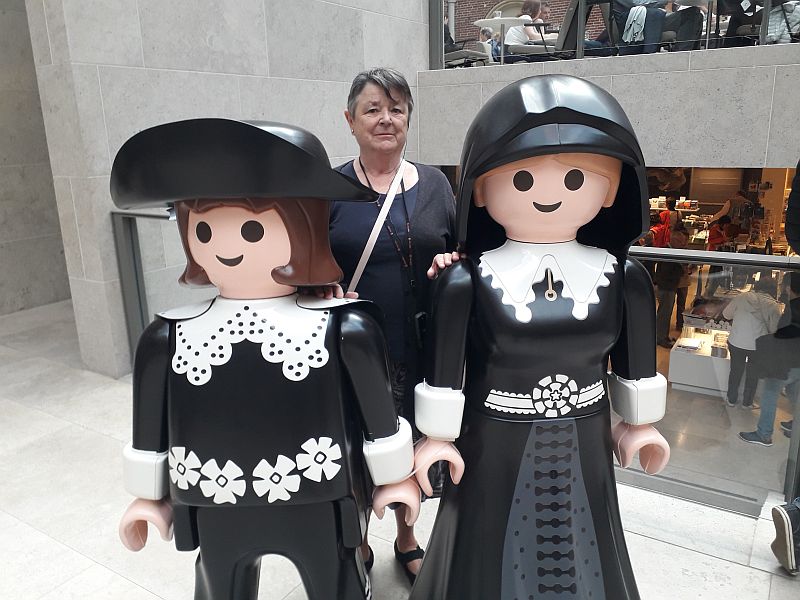
Ever since we journeyed through Russia in 2011, from the Baltic Sea to the Black Sea via the rivers Neva and Volga, we had wanted to join the same two seas by the alternative route that runs through Europe. This route connects from Amsterdam (not quite the Baltic but at least the same area of water} via the Rhine and Danube to reach the Black Sea. Whenever we had looked at the journey previously the price had been prohibitive, but now with the uncertainty over Brexit the price was forecast to rocket away out of our reach and we started to look around again. We contacted Noble-Caledonian, whose cruises we had enjoyed before, and they were able to offer us a last-minute deal that was too good to refuse. It meant that we had to make a lot of last-minute re-arrangements in a great hurry (these included finding somewhere to leave the boat and somewhere to leave Jessop the dog) but everything worked out well so just a couple of weeks later we were on our way to Amsterdam.
The flight from Heathrow was a short one but, as our pilot joked, because of the wind direction we were landing at the far end of a runway that was almost n France; certainly we spent longer taxiing than we had spent flying. We were taken by minibus to see our ship, the MS Royal Emerald, and settled into our cabin; the cabin was simply excellent, with a wonderful all-weather balcony which had a fabulous powered window: with one press of the button the upper half of the glass enclosure slid down to make it an open-air balcony, but another press on the button restored the glass to make the area warm and dry. With Britain and most of Europe still reeling from the 'Beast from the East' and the 'Pest from the West' we had no idea what the weather was likely to be on our trip, so we were glad of the options that would be available to us. Overall the ship seemed excellent; at 450ft its sheer length was rather daunting but at least it was the same shape as a narrow boat (10 times as long as it is wide) and was very much designed for river travel having shallow draught and a flat bottom. We weren't quite the youngest of the 150 passengers, but it was close.
We spent the first couple of days moored in Amsterdam. After a morning in the wonderful Rijksmuseum, seeing such classic works of art as Rembrandt's "The Night Watch", for the afternoon we took a tour of the city by canal boat. We have done this before, many years ago, but truly it is only by water that you can properly appreciate the beauty of this wonderful city.
The following day was a visit that Debbie had wanted to experience for many years: a trip to the Keukenhof Gardens. Open for just a few weeks every spring, these wonderful gardens are the showpiece of all the major Dutch bulb growers. Amid passing acres and acres of bulb fields, we were given just a couple of hours to explore this glorious exhibition whose attractions could easily fill a whole day with its outdoor display fields, themed indoor pavilions, play areas for the children, picnic areas and food outlets galore. : I took a couple of hundred photographs, and have collated just a few of them on one page here to let you view them more easily.
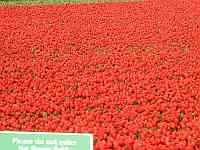 |
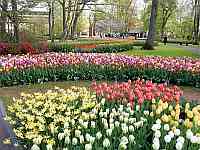 |
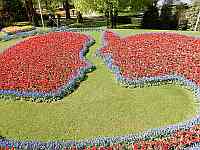 |
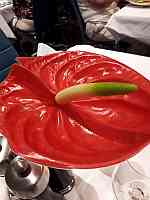 |
Past the bulb fields ... |
... to Keukenhof Gardens ... |
... where this year's theme was 'Love' |
Of course there were beautiful flowers as table decorations on the ship as well |
After leaving Amsterdam by canal we were soon passing through a couple of locks (sluices) to join the mighty River Rhine. A day's travel took us to the city of Cologne; walking around the city we admired the spectacular cathedral (big enough to accommodate 20,000 people), visited a 'Brauhaus' to enjoy tasting some of the local Koelsh beer, and we even managed to do a little bit of shopping before returning to the ship (we wanted to buy some fresh orange juice to keep in the fridge in our cabin)
Continuing up the Rhine, our next stop was the city of Koblenz. We moored in the mouth of the river Moselle, and were met for a walking tour by a wonderful local guide who was very knowledgeable and had a great sense of humour; she told us "Here in Koblenz we have the administrative centre of the German Army, so we make all the important decisions. The Ministry of Defence may decide when we will go to war, but it is we who decide what trousers we will wear"
The walking tour options today, as on most days, included the options of either a long energetic walk in one of several small groups for those passengers who were fully fit, or a shorter and more gentle walk for those whose mobility was somewhat reduced. Unfortunately there were a couple of passengers whose capability was limited to shuffling along slowly for perhaps 100 yards before having to sit down for a long rest, and then often being escorted back to the ship, but they insisted on always joining one of the 'energetic' walking groups so that they would not miss anything. This was intensely frustrating for everybody else in that group whose walk was inevitably delayed or curtailed, and we soon learned to look and see which group they joined and then immediately attach ourselves to a different one. Also rather annoying was an elderly passenger who refused to use the radio headsets which were provided to allow the guides to talk to us all, because she said the earpieces were uncomfortable; she was profoundly deaf and usually turned off her own hearing aids, choosing instead to talk incessantly at an extremely loud volume to everybody (including the guide) even if they were involved in a conversation of their own at the time; we soon learned to give her a wide berth as well!
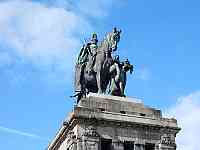 |
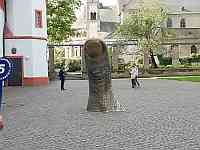 |
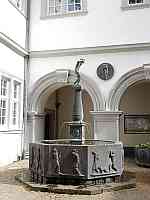 |
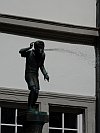 |
Koblenz has statues which are ancient ... |
... and modern ... |
... as well as one of an innocent-looking boy ... |
... who will spit at you every couple of minutes |
Leaving Koblenz we continued up the river and stopped at the little town of Alken below the Berg Thurant, an impressive castle which had been home to one of the infamous mediaeval 'Robber Barons'. These barons used to stretch a chain across the river and demand payment from the merchant ships before they would lower the chain to permit their passage - meanwhile training various items of weaponry upon the unfortunate ship, by way of encouragement to make the payment.
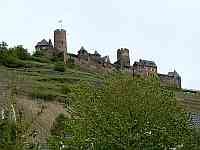 |
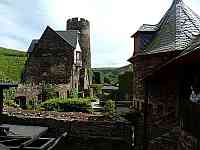 |
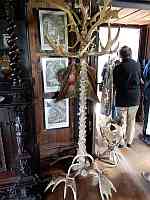 |
The impressive castle of Berg Thurant, high on the hillside |
The interior of Berg Thurant is beautiful |
Their room of hunting trophies includes this spectacular (if somewhat grisly) coat stand |
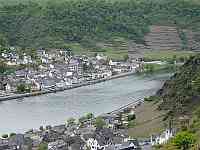 |
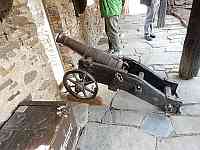 |
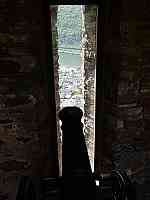 |
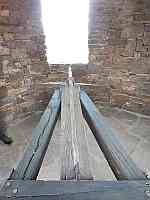 |
The view across the river from Berg Thurant |
Cannons are trained on the river ... |
... through narrow slits in the walls |
Huge crossbows provide backup fire |
Below the castle, near the river, is a delightful little 11th century chapel. Particularly impressive were the original wall-paintings inside, which are still in wonderful condition
Now we were in the Rhine Gorge, with its many castles overlooking the river. This one reminded me particularly of the castles which are traditionally painted on British narrow-boats. I have also collated a single page that highlights many of the different castles that we passed:
As we progressed up the fast-flowing river we met many commercial craft, often extremely heavily loaded. The 'blue-board' system was in constant use; under this system, any ship who wishes to use the 'wrong' side of the river, either to take advantage of the deeper water around the outside of the bend or conversely to take advantage of the slower current in the shallows around the inside of the bend, would traditionally display a blue board to signify their intentions. These days the boards are usually electrically operated and carry a bright flashing light, but the convention is universal on the Rhine and can cause some interesting steering challenges for the operator of a mere pleasure-boat. Note, the blue-board system is not in use in the UK, please don't try it on the Thames!
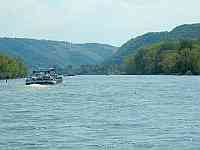 |
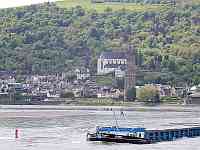 |
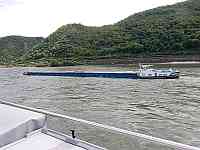 |
The river was getting quite busy with heavily-loaded commercial traffic |
||
The next day started wet and windy, but the weather improved during the morning and allowed us all to enjoy a period on deck as we passed the famous Lorelei rocks. There were many shipwrecks here in the past, giving rise to the legend of the siren whose beautiful singing would lure sailors on to the rocks. The statue of this infamous sprite is surprisingly small but very beautiful; the currents around the rocks were really fierce and it is easy to see how this stretch of river gained its infamous reputation.
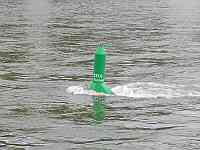 |
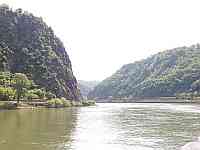 |
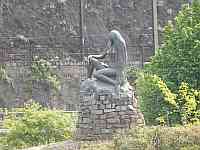 |
The current in the river was very fast-flowing ... |
... especially here at the Lorelei Rocks ... |
... where this little statue of the famous siren may be found |
Our next stop was the small town of Ruedesheim, whose claim to fame (apart from their wonderful flaming coffee) is a simply amazing museum of mechanical musical instruments. I found these marvels of (mainly) Victorian ingenuity absolutely fascinating, and I have included a number of YouTube videos below for you to enjoy:
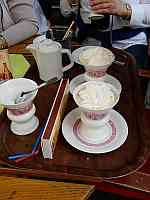 |
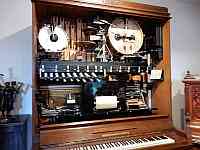 |
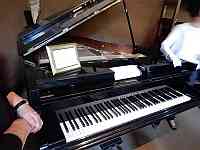 |
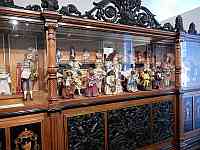 |
Ruedesheim coffee; with added sugar, flaming brandy, whipped cream, and chocolate sprinkles |
Ruedesheim; the complex interior of a mechanical player |
This piano records the playing on to a paper roll, and can then play it backPLAY VIDEO |
A host of small automatons make up the orchestra in this playerPLAY VIDEO |
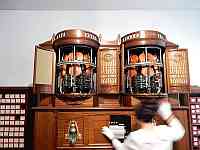 |
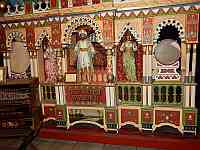 |
 |
 |
 |
An extremely unusual multi-violin playerPLAY VIDEO |
The spectacular front of a fairground organPLAY VIDEO |
This automated organ sounded magnificentPLAY VIDEO |
A most unusual accordion playerPLAY VIDEO |
An extremely versatile playerPLAY VIDEO |
The weather had finally improved, and we enjoyed sitting on the top deck in blazing sunshine as we continued up the river to Mainz. Of particular interest at Mainz was the Gutenburg museum. Gutenburg invented the printing press in the 15th century, and famously used it to produce the Gutenburg Bible of which a few copies survive to this day. We were treated to a demonstration on a replica of the original press; what a slow and tedious process it was (and even then the illuminations of the text were hand-painted afterwards). I was intrigued by the fact that multiple versions of every letter were used, in slightly different widths, to achieve justified margins; this was because it never occurred to the printers of the time that it was only necessary to adjust the sizes of the blank spaces between words to achieve the same effect.
Mainz also has the small church of St Stephan, which is well worth a visit to see the wonderful stained glass windows which were supplied by the famous artist Marc Chagall as his contribution to a German-Jewish reconciliation.
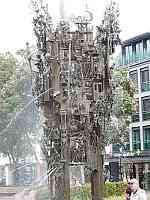 |
||
We found this amazing fountain in Mainz
|
||
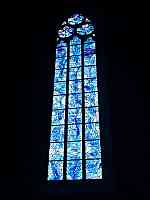 |
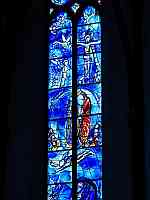 |
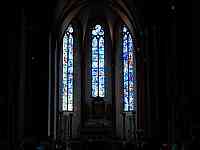 |
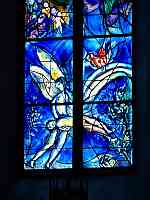 |
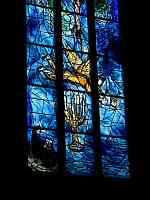 |
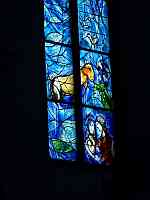 |
St Stephan's Church in Mainz: spectacular glass windows designed and hand-crafted by Marc Chagalle |
||
Mainz was also the point at which we would leave the River Rhine and, passing through our first lock since the Netherlands, we turned left to continue our journey on the River Main ...
All pictures on this site are © Allan Jones unless otherwise stated